#3 The Dynamics of the Argumentation on Zwarte Piet
- AnissaSdm
- Nov 23, 2019
- 5 min read
Updated: Dec 6, 2019
The Particularities of the Textual Argumentation Online and on Twitter
A debate can be defined as a formal or informal discussion about a given topic, in which involved parties confront different points of views. It can take diverse forms, from a governmental debate on a proposed policy to an organized academic discussion or an online debate. However, each form comes with a different set of norms, practices and mediation mechanisms.
In line with these disparities, internet-based debates have certain particularities that must be well explained before being able to analyze rhetorical and argumentative strategies and understand the way people participate. The online world proposes a certain perpetuity of the published information. It also enables anyone to join such a discussion and anyone to be a witness of this. As a result, it can make online debates more dynamic, and unstable, especially since the mediator might not be always present, able to manage all additional comments and might even be non-existent.
Additionally, Twitter offers a specific framework in which debates can be expressed. Messages, tweets, are restricted to 280 characters but can be complemented by links, videos and other images. Members can all publish posts, comment each other’s posts and create threads, a series of tweets written by the same member and inter-connected.
Because of all these specificities, the debate on Zwarte Piet on Twitter is often straightforward, synthetic but might also, sometimes, be disorganized and simplistic. The “rules of the game” of the debate change.
The Main Divide: the Linguistics of Zwarte Piet
A very simple linguistic distinction appearing in tweets in English enables to summarize the debate surrounding the figure of Zwarte Piet online and on Twitter. For pro-Zwarte Piet activists, he is seens as Sinterklaas’ friendly helper / assistant / companion. On the opposite, for anti-racist activists, the word describing best the position of Zwarte Piet is the one of servant. Indeed, when the first nouns refer to a somewhat equal relationship, the second one implies a colonial relationship with the superiority of the white master, Sinterklaas.
Furthermore, the choice of the preferred noun by the user is often accompanied by a specific vocabulary bringing Zwarte Piet to light in either a positive or negative manner. Pro-Zwarte Piet activists would use the words of “tradition”, “identity”, “culture” to symbolize the meaning of Zwarte Piet, and “celebration”, “candies”, “presents”, “happy”, “children” among others to portray an innocent physical realm. On the opposite, anti-racist activists will frame the previous vocabulary in negative language to deny its accuracy and refer to the terminology of anti-racism (by using words including “stereotype”, “cliché”, “racist” and so on).
This linguistic distinction enables to easily identify the two parties and enables to understand the argumentation that flows from it.

The Two Currents and their Argumentation on Twitter: a Dynamic Process
The argumentation of the Zwarte Piet debate online is profoundly dynamic. Indeed, each trend perpetually offload the burden onto the other. Each possible argument launched by one party is only a response to the previous one given by the other. In that sense, all arguments have to be linked to one another.
When pro-Zwarte Piet activists explain that Zwarte Piet is a symbol of Dutch national identity, they utilize a powerful object that is difficult to criticize. However, in response, anti-racist activists explain that Zwarte Piet is to be seen as an example of the still presence of racism and as a trace of the history of slavery.
Then, pro-Zwarte Piet activists will go on and defend Zwarte Piet under the concept of tradition, which is to leave untouched, unquestioned and, most importantly, unchanged. However, anti-racists will demonstrate that the Dutch society has changed, and so should traditions.
Rhetorically, if all of these statements are argumentative, they are rarely qualified (explaining the limitation of their validity) or guaranteed (sourced). Maybe this lack is closely related to the format of Twitter: on the writer’s side, there is not enough space to construct strong arguments and, on the reader’s side, there is an expectation for easy to understand and absorb content. And, if the aim of the writer is to get a response from their public (comments, likes, re-tweets), then there is an even greater incentive to meet the reader’s expectations.
Attempts at Diverting the Core Debate
Another significant trend to notice in the overall argumentation of the Zwarte Piet debate is the capacity of people on Twitter to try to divert the core debate either by using arguments that are shaky or that involve a third party without a rational say in the debate. Similarly, the argumentation on Twitter mainly lies on two basis: the questioning of the original story and the actual blackness of Zwarte Piet and the power of lived experience regarding racism.
Pro-Zwarte Piet activists will claim both that Zwarte Piet is black so be it and that Zwarte Piet is actually not black but covered with soot. Anti-racist activists will respond by emphasizing the blackness of Zwarte Piet and its usual attributes (curly hair, thick red lips and golden jewelry).
Similarly, pro-Zwarte Piet will appeal to children by stating that the debates are ruining the festivities for them. However, children will not take part of the debate. And, anti-racism activists will draw on the the way the festivities are negatively experienced by black and other non-white children in Dutch schools.
Zwarte Piet: Racism or not?
In the center of the debate on Zwarte Piet online and in the physical world is the notion of racism. What is often discussed is whether it is a racist tradition and whether it should change then.
However, it is fascinating to observe how this discussion creates major tensions, and confusion between what is means to be racist vs to perpetuate a racist tradition and between what belongs to the personal sphere and what is a matter of culture. Essentially, there is a great tendency online to feel personally attacked when the object of the debate remains Zwarte Piet and not the user’s life.
Adding to this trend, Twitter enables to share personal experiences and what we could identify as “believed experiences” (when speaking on behalf of another person or another community) to fuel the debate on racism. Black people will share their view on the topic, whether they think it is racist or not. And, white Dutch people will speak on behalf of black people.
The Pitfall of Twitter: the Lack of Argumentation
One major pitfall of Twitter and other social media platforms is the extent to which the absence of argumentation can be utilized. Non-argumentative statements such as questions, digressions or other non-relevant declarations are extremely more frequent online and on Twitter than in physically organized debates.
People on both sides would draft simplistic messages, jump to conclusion or even bounce back with direct and violent attacks to one another.
If these tweets do not serve the argumentation as it does not enable to convince or persuade, they may bring life and bustle to the debate, which is inherent to social media.

Concluding Remarks
The extent to which the “rules of the game” of a debate on Twitter can change is striking. The apparent restriction of its format actually enables users to be more direct by essentializing their language, argumentation and by using truisms (obvious claims based on stereotyped ideas). The debate on Zwarte Piet on Twitter seems to hardly bring anything new to the debate we know from the Dutch national news. However, it might enable more people to participate, be exposed to such a debate and share their own personal experience of it as a racist tradition that must change.




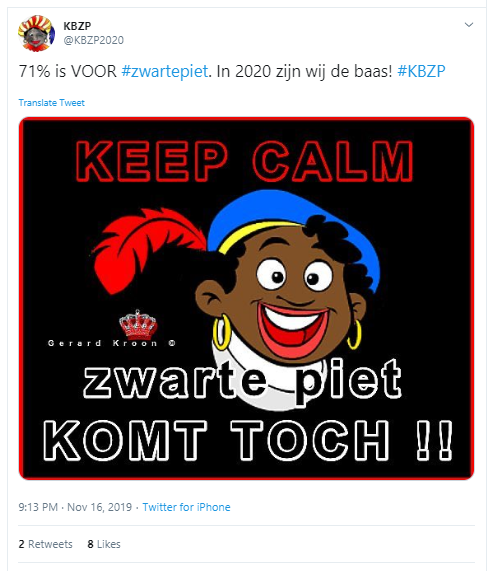

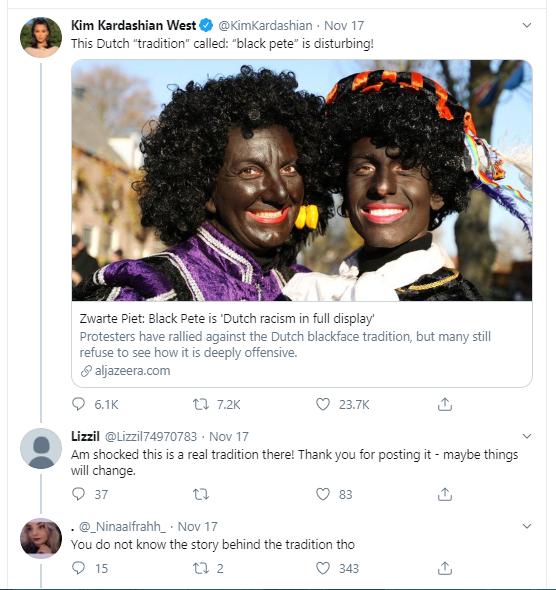

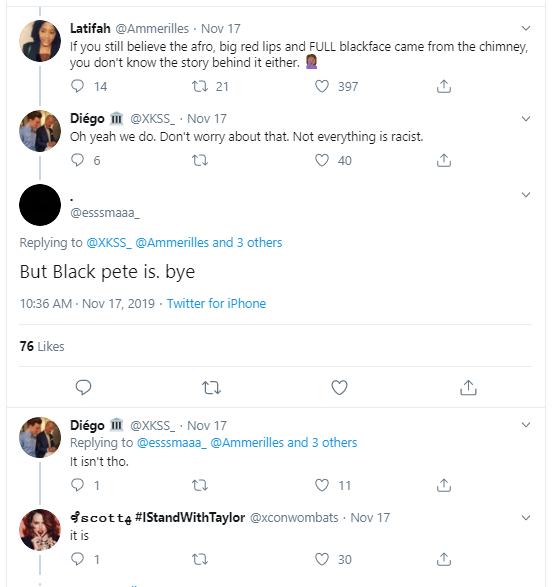

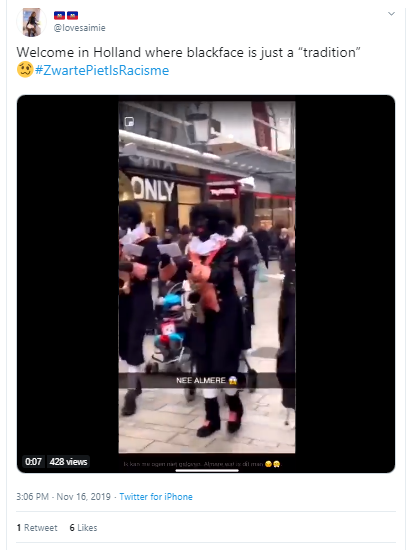


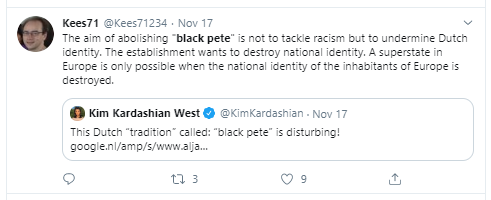

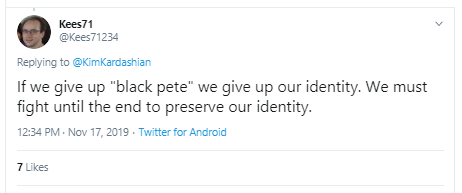





































Comments